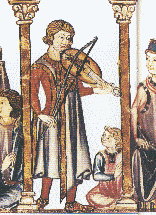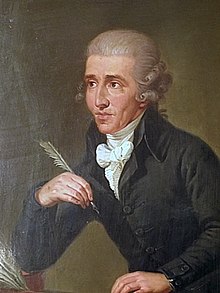Cara membuat Wifi hotspot sendiri dirumah
Kepada pembaca yang mempunyai sambungan broadband dirumah (Streamyx, Penangfon, etc),tahukah anda bahawa anda dapat menjadikan rumah anda sebagai zon WIFI hotspot seperti yang banyak terdapat di restoran-restoran mamak, cybercafe dan lain-lain. Dengan sedikit kelengkapan dan kemahiran,anda dapat menyiapkan Wifi hotspot sendiri dengan mudah. Kelebihan : 1.Jika dahulu hanya sebiji komputer atau laptop dapat mengakses internet, kini semua komputer dan laptop dirumah anda dapat mengakses internet serentak! 2.Jika rumah anda adalah rumah dua tingkat, tidak menjadi masalah untuk komputer dan laptop samaada ditingkat bawah / atas untuk mengakses internet asalkan mempunyai antena wireless. 3.Dapat bermain game LAN beramai ramai jika mempunyai banyak PC.Contohnya game Counter Strike, Red Alert, Dota, dan lain-lain. 4.Dapat berkongsi file-file dengan seisi rumah dengan mudah. Jika anda berminat untuk mengetahui caranya, ikuti tutorial ini :) Tutorial ini khas untuk pengguna streamyx yang menggunakan modem biasa (bukannya Wireless Modem) Kelengkapan yang diperlukan : 1.Wireless Router 2.Kabel LAN (2 unit) Langkah-langkah : Bahagian A – Sambungan hardware 1.Dapatkan Wireless Router dimana-mana kedai komputer.Sekiranya anda mencari wireless router yang agak murah dan mempunyai perfomance yang baik, saya sarankan anda membeli wireless router Belkin.Boleh didapati di Plaza Lowyat dengan harga rm99. Wireless Router Belkin :  2.Jika anda menggunakan modem yang dibekalkan oleh tmnet, sila cabut kabel LAN yang dihubungkan kepada pc anda dari modem tersebut. contoh modem streamyx :
2.Jika anda menggunakan modem yang dibekalkan oleh tmnet, sila cabut kabel LAN yang dihubungkan kepada pc anda dari modem tersebut. contoh modem streamyx :  3.Sekarang sambungkan kabel LAN yang telah dicabut dari pc ke port berlabel Modem pada Wireless Router anda. contoh:
3.Sekarang sambungkan kabel LAN yang telah dicabut dari pc ke port berlabel Modem pada Wireless Router anda. contoh:  4.Sekarang modem anda telah disambung ke Wireless Router. 5.Dengan menggunakan satu lagi kabel LAN, sambungkan PC anda ke wireless Router dengan mengunakan port berlabel Computer pada Wireless Router anda.
4.Sekarang modem anda telah disambung ke Wireless Router. 5.Dengan menggunakan satu lagi kabel LAN, sambungkan PC anda ke wireless Router dengan mengunakan port berlabel Computer pada Wireless Router anda.  6.Modem yang telah disambung kepada router.
6.Modem yang telah disambung kepada router.  Bahagian B – Akses Router 1.Pergi ke komputer anda, klik Start->Run->cmd
Bahagian B – Akses Router 1.Pergi ke komputer anda, klik Start->Run->cmd  2.Dalam tetingkap cmd, taip ipconfig dan tekan enter.
2.Dalam tetingkap cmd, taip ipconfig dan tekan enter.  3.Sekarang data-data berkaitan IP telah terpapar pada skrin.dapatkan Default Gateway untuk Local Area Connection.
3.Sekarang data-data berkaitan IP telah terpapar pada skrin.dapatkan Default Gateway untuk Local Area Connection.  Dalam contoh diatas, default gateway ialah 192.168.2.1 4.Sekarang sila masuk ke browser internet anda (Firefox, Opera, IE, etc) dan taip default gateway tersebut sebagai addres dan tekan enter.
Dalam contoh diatas, default gateway ialah 192.168.2.1 4.Sekarang sila masuk ke browser internet anda (Firefox, Opera, IE, etc) dan taip default gateway tersebut sebagai addres dan tekan enter.  5.Sekarang anda telah berjaya mengakses bahagian Setting router tersebut.
5.Sekarang anda telah berjaya mengakses bahagian Setting router tersebut.  Bahagian C – Membuat sambungan internet 1.Untuk memasukkan username dan password streamyx anda, sila cari bahagian yang bernama PPoE.(Anda perlu mengexplore sendiri kerana setiap router mempunyai interface yang berbeza).
Bahagian C – Membuat sambungan internet 1.Untuk memasukkan username dan password streamyx anda, sila cari bahagian yang bernama PPoE.(Anda perlu mengexplore sendiri kerana setiap router mempunyai interface yang berbeza).  2.Klik Next. 3.Masukkan Username dan Password untuk streamyx anda dan klik Apply Changes.
2.Klik Next. 3.Masukkan Username dan Password untuk streamyx anda dan klik Apply Changes.  4.Sekarang Router anda akan restart.Selepas itu setiap komputer dan laptop yang connect ke wireless router anda akan mempunyai sambungan internet. Bahagian D – Sekuriti Wifi 1.Bagi mengelakkan orang lain menggunakan Wifi anda, anda perlu meletakkan sekuriti terhadap wifi anda.Dalam contoh ini, saya akan menggunakan WEP. 2.Cari bahagian bernama WEP.WEP selalunya terletak dalam bahagian security..(Anda perlu mengexplore sendiri kerana setiap router mempunyai interface yang berbeza).
4.Sekarang Router anda akan restart.Selepas itu setiap komputer dan laptop yang connect ke wireless router anda akan mempunyai sambungan internet. Bahagian D – Sekuriti Wifi 1.Bagi mengelakkan orang lain menggunakan Wifi anda, anda perlu meletakkan sekuriti terhadap wifi anda.Dalam contoh ini, saya akan menggunakan WEP. 2.Cari bahagian bernama WEP.WEP selalunya terletak dalam bahagian security..(Anda perlu mengexplore sendiri kerana setiap router mempunyai interface yang berbeza).  3.Masukkan password yang dikehendaki dan klik Apply Changes.
3.Masukkan password yang dikehendaki dan klik Apply Changes.  4.Sekarang setiap komputer atau laptop yang mahu connect ke Wifi anda akan diminta password.Jika anda telah connect ke wifi tersebut sebelum password diletakkan, anda terpaksa connect kembali dan meletakkan password. Bahagian E – Nama Wifi 1.Untuk mengubah nama wifi anda, cari bahagian bernama SSID. 2.Masukkan nama SSID baru yang anda suka dan klik Apply Changes.
4.Sekarang setiap komputer atau laptop yang mahu connect ke Wifi anda akan diminta password.Jika anda telah connect ke wifi tersebut sebelum password diletakkan, anda terpaksa connect kembali dan meletakkan password. Bahagian E – Nama Wifi 1.Untuk mengubah nama wifi anda, cari bahagian bernama SSID. 2.Masukkan nama SSID baru yang anda suka dan klik Apply Changes.  3.Sekarang connection Wifi anda telah bernama JomPHP! Sekarang anda telah siap setting wifi pertama anda.Anda boleh mencabut kabel LAN ke pc sekarang sekiranya hanya mahu menggunakan wireless.Untuk mengakses kembali router, hanya taip ip default gateway di web browser anda. Sekiranya anda follow betul-betul tutorial ini, tahniah untuk anda.Anda telah menjimatkan duit sehingga rm100 sekiranya mahu mengupah orang untuk membuat wifi dirumah anda. Ringkasan : 3 point iaitu PPoE, SSID dan WEP.Sekiranya anda faham 3 point ini, anda dapat mengsetup semua router yang diberikan kepada anda. Selamat mencuba ;)
3.Sekarang connection Wifi anda telah bernama JomPHP! Sekarang anda telah siap setting wifi pertama anda.Anda boleh mencabut kabel LAN ke pc sekarang sekiranya hanya mahu menggunakan wireless.Untuk mengakses kembali router, hanya taip ip default gateway di web browser anda. Sekiranya anda follow betul-betul tutorial ini, tahniah untuk anda.Anda telah menjimatkan duit sehingga rm100 sekiranya mahu mengupah orang untuk membuat wifi dirumah anda. Ringkasan : 3 point iaitu PPoE, SSID dan WEP.Sekiranya anda faham 3 point ini, anda dapat mengsetup semua router yang diberikan kepada anda. Selamat mencuba ;)
READ MORE
 2.Jika anda menggunakan modem yang dibekalkan oleh tmnet, sila cabut kabel LAN yang dihubungkan kepada pc anda dari modem tersebut. contoh modem streamyx :
2.Jika anda menggunakan modem yang dibekalkan oleh tmnet, sila cabut kabel LAN yang dihubungkan kepada pc anda dari modem tersebut. contoh modem streamyx :  3.Sekarang sambungkan kabel LAN yang telah dicabut dari pc ke port berlabel Modem pada Wireless Router anda. contoh:
3.Sekarang sambungkan kabel LAN yang telah dicabut dari pc ke port berlabel Modem pada Wireless Router anda. contoh:  4.Sekarang modem anda telah disambung ke Wireless Router. 5.Dengan menggunakan satu lagi kabel LAN, sambungkan PC anda ke wireless Router dengan mengunakan port berlabel Computer pada Wireless Router anda.
4.Sekarang modem anda telah disambung ke Wireless Router. 5.Dengan menggunakan satu lagi kabel LAN, sambungkan PC anda ke wireless Router dengan mengunakan port berlabel Computer pada Wireless Router anda.  6.Modem yang telah disambung kepada router.
6.Modem yang telah disambung kepada router.  Bahagian B – Akses Router 1.Pergi ke komputer anda, klik Start->Run->cmd
Bahagian B – Akses Router 1.Pergi ke komputer anda, klik Start->Run->cmd  2.Dalam tetingkap cmd, taip ipconfig dan tekan enter.
2.Dalam tetingkap cmd, taip ipconfig dan tekan enter.  3.Sekarang data-data berkaitan IP telah terpapar pada skrin.dapatkan Default Gateway untuk Local Area Connection.
3.Sekarang data-data berkaitan IP telah terpapar pada skrin.dapatkan Default Gateway untuk Local Area Connection.  Dalam contoh diatas, default gateway ialah 192.168.2.1 4.Sekarang sila masuk ke browser internet anda (Firefox, Opera, IE, etc) dan taip default gateway tersebut sebagai addres dan tekan enter.
Dalam contoh diatas, default gateway ialah 192.168.2.1 4.Sekarang sila masuk ke browser internet anda (Firefox, Opera, IE, etc) dan taip default gateway tersebut sebagai addres dan tekan enter.  Bahagian C – Membuat sambungan internet 1.Untuk memasukkan username dan password streamyx anda, sila cari bahagian yang bernama PPoE.(Anda perlu mengexplore sendiri kerana setiap router mempunyai interface yang berbeza).
Bahagian C – Membuat sambungan internet 1.Untuk memasukkan username dan password streamyx anda, sila cari bahagian yang bernama PPoE.(Anda perlu mengexplore sendiri kerana setiap router mempunyai interface yang berbeza).  2.Klik Next. 3.Masukkan Username dan Password untuk streamyx anda dan klik Apply Changes.
2.Klik Next. 3.Masukkan Username dan Password untuk streamyx anda dan klik Apply Changes.  4.Sekarang Router anda akan restart.Selepas itu setiap komputer dan laptop yang connect ke wireless router anda akan mempunyai sambungan internet. Bahagian D – Sekuriti Wifi 1.Bagi mengelakkan orang lain menggunakan Wifi anda, anda perlu meletakkan sekuriti terhadap wifi anda.Dalam contoh ini, saya akan menggunakan WEP. 2.Cari bahagian bernama WEP.WEP selalunya terletak dalam bahagian security..(Anda perlu mengexplore sendiri kerana setiap router mempunyai interface yang berbeza).
4.Sekarang Router anda akan restart.Selepas itu setiap komputer dan laptop yang connect ke wireless router anda akan mempunyai sambungan internet. Bahagian D – Sekuriti Wifi 1.Bagi mengelakkan orang lain menggunakan Wifi anda, anda perlu meletakkan sekuriti terhadap wifi anda.Dalam contoh ini, saya akan menggunakan WEP. 2.Cari bahagian bernama WEP.WEP selalunya terletak dalam bahagian security..(Anda perlu mengexplore sendiri kerana setiap router mempunyai interface yang berbeza).  3.Masukkan password yang dikehendaki dan klik Apply Changes.
3.Masukkan password yang dikehendaki dan klik Apply Changes.  4.Sekarang setiap komputer atau laptop yang mahu connect ke Wifi anda akan diminta password.Jika anda telah connect ke wifi tersebut sebelum password diletakkan, anda terpaksa connect kembali dan meletakkan password. Bahagian E – Nama Wifi 1.Untuk mengubah nama wifi anda, cari bahagian bernama SSID. 2.Masukkan nama SSID baru yang anda suka dan klik Apply Changes.
4.Sekarang setiap komputer atau laptop yang mahu connect ke Wifi anda akan diminta password.Jika anda telah connect ke wifi tersebut sebelum password diletakkan, anda terpaksa connect kembali dan meletakkan password. Bahagian E – Nama Wifi 1.Untuk mengubah nama wifi anda, cari bahagian bernama SSID. 2.Masukkan nama SSID baru yang anda suka dan klik Apply Changes.  3.Sekarang connection Wifi anda telah bernama JomPHP! Sekarang anda telah siap setting wifi pertama anda.Anda boleh mencabut kabel LAN ke pc sekarang sekiranya hanya mahu menggunakan wireless.Untuk mengakses kembali router, hanya taip ip default gateway di web browser anda. Sekiranya anda follow betul-betul tutorial ini, tahniah untuk anda.Anda telah menjimatkan duit sehingga rm100 sekiranya mahu mengupah orang untuk membuat wifi dirumah anda. Ringkasan : 3 point iaitu PPoE, SSID dan WEP.Sekiranya anda faham 3 point ini, anda dapat mengsetup semua router yang diberikan kepada anda. Selamat mencuba ;)
3.Sekarang connection Wifi anda telah bernama JomPHP! Sekarang anda telah siap setting wifi pertama anda.Anda boleh mencabut kabel LAN ke pc sekarang sekiranya hanya mahu menggunakan wireless.Untuk mengakses kembali router, hanya taip ip default gateway di web browser anda. Sekiranya anda follow betul-betul tutorial ini, tahniah untuk anda.Anda telah menjimatkan duit sehingga rm100 sekiranya mahu mengupah orang untuk membuat wifi dirumah anda. Ringkasan : 3 point iaitu PPoE, SSID dan WEP.Sekiranya anda faham 3 point ini, anda dapat mengsetup semua router yang diberikan kepada anda. Selamat mencuba ;)Membangun Proxy Server Sendiri
Membangun Proxy Server Sendir
Ya, Proxy Server yang kita bangun ini mampu menyimpan cache yang berasal elemen dari sebuah situs, baik gambar ataupun isi situs tersebut agar menghemat bandwidth saat kita mengunjungi situs tersebut kemudian hari. Penghematan yang dapat dilakukan proxy ini mencapai 60%.
Adalah SquidMan, aplikasi proxy dengan tampilan GUI yang berbasis Squid ini mampu melakukan itu semua dengan mudah. Agar lebih jelasnya, mari kita mencoba melakukan instalasi SquidMan.
Pertama-tama, download paket Installer terbaru SquidMan yang bisa Anda dapatkan disini.
Kemudian drag aplikasi SquidMan menuju folder Applications. Lalu jalankan dan buka jendela Preferences milik SquidMan (cmd + ,).


Tuliskan alamat 127.0.0.1 dan 3128 di kolom Web Proxy (HTTP). Pastikan kolom tersebut sudah tercentang. Klik OK dan Apply untuk mengaktifkannya.
Kembali lagi ke SquidMan, dan tekan Start Squid untuk menjalankan proxy server.
Membuat PC biasa menjadi ROUTER
MikroTik RouterOS™ adalah sistem operasi dan yang dapat digunakan untuk menjadikan komputer manjadi router network yang handal, mencakup berbagai fitur lengkap untuk network dan wireless.
Kemudian di extrack dan kemudian burn ke CD itu file ISO nya.1. Install Mikrotik OS
– Siapkan PC, minimal Pentium I juga gak papa RAM 64,HD 500M atau pake flash memory 64
– Di server / PC kudu ada minimal 2 ethernet, 1 ke arah luar dan 1 lagi ke Network local
– Burn Source CD Mikrotik OS masukan ke CDROM
– Boot dari CDROM
– Ikuti petunjuk yang ada, gunakan syndrom next-next dan default
– Install paket2 utama, lebih baiknya semua packet dengan cara menandainya (mark)
– Setelah semua paket ditandai maka untuk menginstallnya tekan “I”
– Lama Install normalnya ga sampe 15menit, kalo lebih berarti gagal, ulangi ke step awal
– Setelah diinstall beres, PC restart akan muncul tampilan login
2. Setting dasar mikrotik
Langkah awal dari semua langkah konfigurasi mikrotik adalah setting ip
Hal ini bertujuan agar mikrotik bisa di remote dan dengan winbox dan memudahkan kita untuk
melakukan berbagai macam konfigurasi
– Login sebaga admin degan default password ga usah diisi langsung enter
Gantilah dengan ip address anda dan interface yg akan digunakan untuk meremote sementara
Di sini akan saya terangkan dengan menggunakan 2 cara yaitu dengan dengan text dan winbox.
I. Langkah setting Mikrotik TEXT
Mari kita mulai dengan asumsi proses install sudah berhasil
1. Install – OK
2. Setting IP eth1 222.124.xxx.xxx (dari ISP)
perintah :
ip address add address 222.124.xxx.xxx netmask 255.255.255.xxx interface ether1
IP tersebut adalah IP public / IP yang yang ada koneksi Internet
3. Setting IP eth2 192.168.1.254
perintah :
ip address add address 192.168.1.254 netmask 255.255.255.0 interface ether2
IP tersebut adalah IP Local anda.
Sekarang lakukan ping ke dan dari komputer lain, setelah konek lanjutkan ke langkah
berikutnya, kalo belum ulangi dari langkah no 2.
4. Setting Gateway
perintah :
ip route add gateway=222.124.xxx.xxx (dari ISP)
5. Setting Primary DNS
perintah :
ip dns set primary-dns=203.130.208.18 (dari ISP)
6. Setting Secondary DNS
perintah :
ip dns set secondary-dns=202.134.0.155 (dari ISP)
7. Setting Routing masquerade ke eth1
perintah :
ip firewall nat add chain=srcnat action=masquerade out-interface=ether1
Untuk terakhir lakukan test ping ke Gateway / ke yahoo.com, bila konek maka Mikrotik anda dah siap
di gunakan.
II. Langkah setting Mikrotik Via WinBox
1. Setelah install Mikrotik sudah OK, selanjutnya masukkan IP sembarang untuk remote.
Misal
ip address add address 192.168.1.254 netmask 255.255.255.0 interface ether2
Kemudian buka browser dengan alamat IP tadi, dan download Winbox
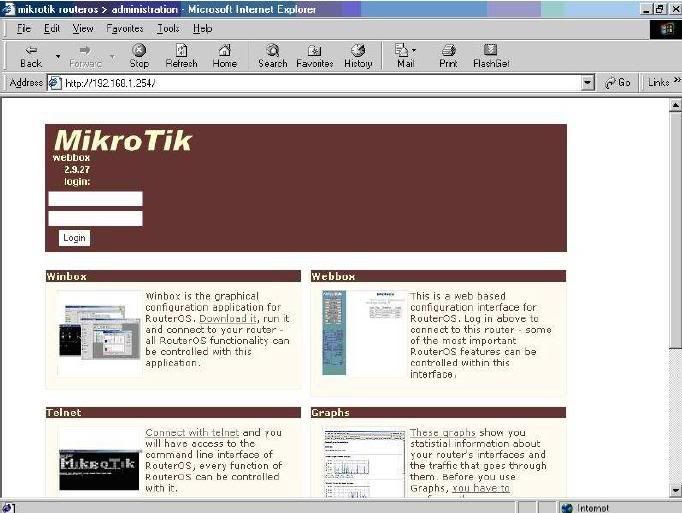
2. Buka Winbox yang telah di download tadi
3. Di tampilan Winbox, pada kolom Connect To masukkan no IP tadi (192.168.1.254) dengan
Login : admin password : kosong. Kemudian klik tombol Connect

4. Login ke Mikrotik Via Winbox berhasil

5. Klik IP —> ADDRESS
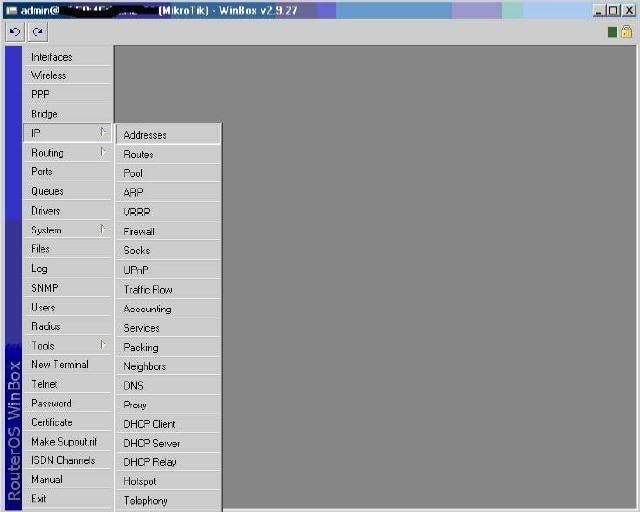
6. Ini adalah tampilan dari address

7. Kemudian masukkan IP public (dari ISP)
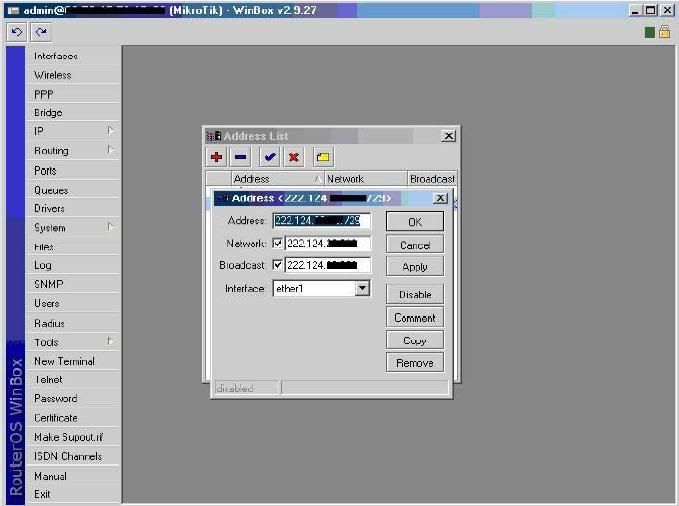
8. Ini daftar IP pada 2 ethernet

9. Setting Gateway, IP —> Routes
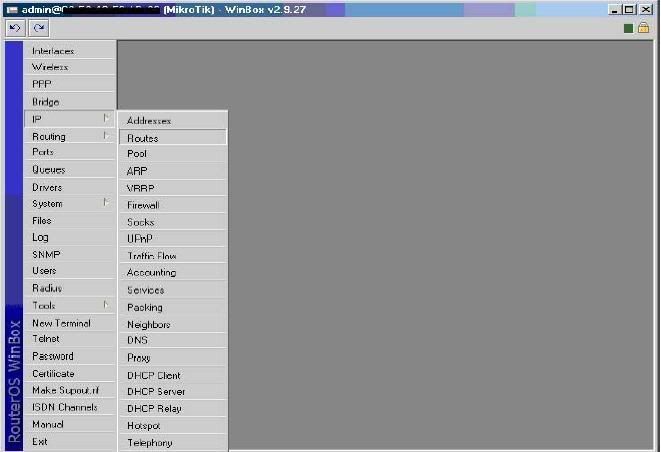
10. Masukkan IP GATEWAY (dari ISP)
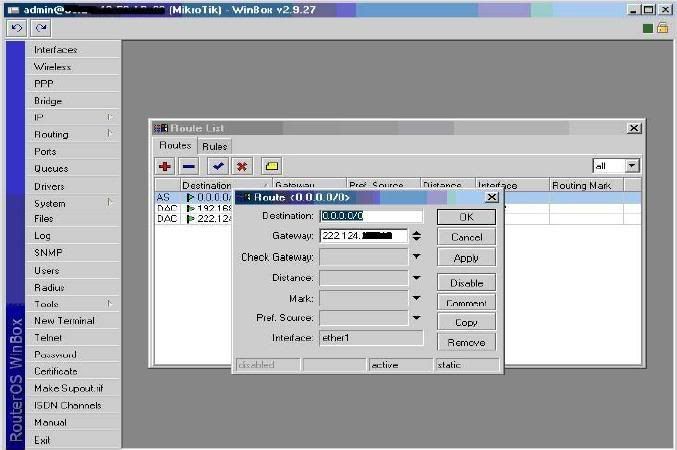
11. Hasil ROUTING
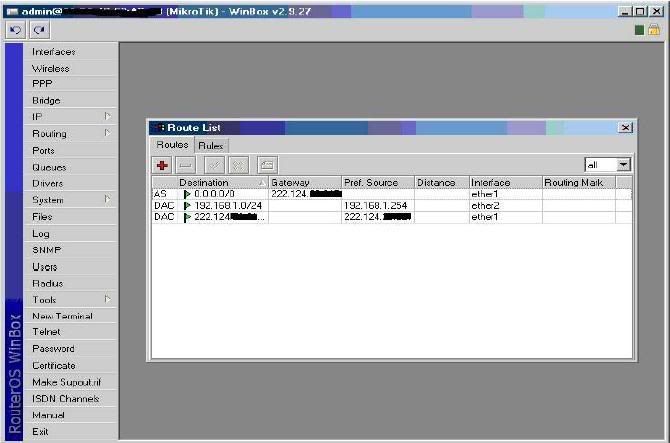
12. Masukkan Primary DNS dan Secondary DNS (dari ISP)
Kemudian klik Apply dan OK
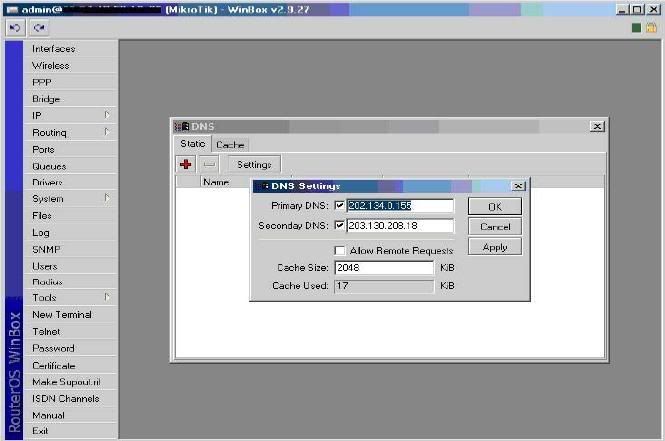
13. Setting MASQUERADE
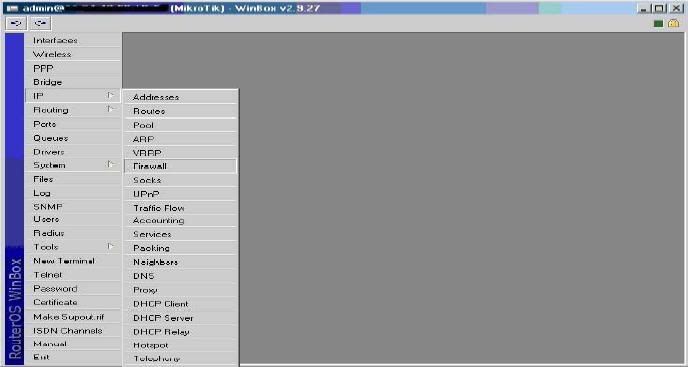
14. Klik IP —> Firewall
15. Kemudian pilih NAT
16. Pada tab General
pada Chain pilih srcnat
pada Out. Interface pilih ether1
pada tab Action pilih masquerade
Kemudian klik Apply dan OK

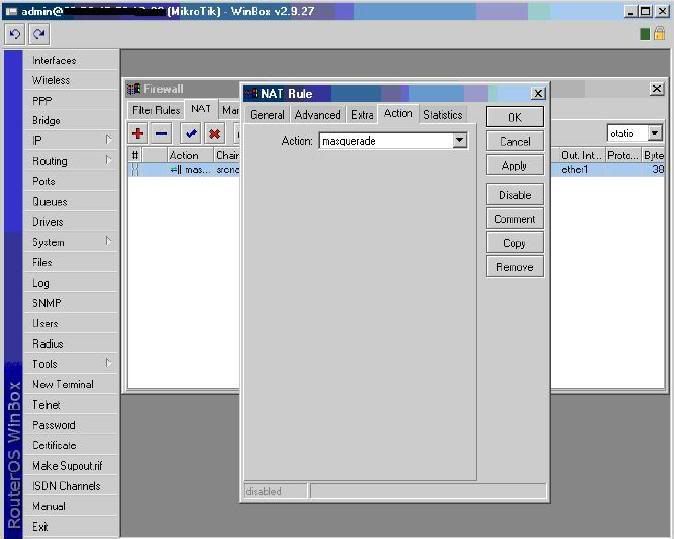
Sumber : http://miji.wordpress.com/2007/03/24/instal-router-menggunakan-mikrotik-routeros/
Like this
Classical music
This article is about Western art music from 1000 AD to the present. For Western art music from 1750 to 1820, see Classical period (music). For other classical music traditions, see List of classical and art music traditions.
Classical music is the art music produced in, or rooted in, the traditions of Western liturgical and secular music, encompassing a broad period from roughly the 11th century to present times.[1] The central norms of this tradition became codified between 1550 and 1900, which is known as the common practice period.
European music is largely distinguished from many other non-European and popular musical forms by its system of staff notation, in use since about the 16th century. Western staff notation is used by composers to prescribe to the performer the pitch, speed, meter, individual rhythms and exact execution of a piece of music. This leaves less room for practices such as improvisation and ad libitum ornamentation, that are frequently heard in non-European art music (as in Indian classical music and Japanese traditional music) and popular music.
The term "classical music" did not appear until the early 19th century, in an attempt to "canonize" the period from Johann Sebastian Bach to Beethoven as a golden age. The earliest reference to "classical music" recorded by the Oxford English Dictionary is from about 1836.
Electric instruments such as the electric guitar appear occasionally in the classical music of the 20th and 21st centuries. Both classical and popular musicians have experimented in recent decades with electronic instruments such as the synthesizer, electric and digital techniques such as the use of sampled or computer-generated sounds, and the sounds of instruments from other cultures such as the gamelan.
None of the bass instruments existed until the Renaissance. In Medieval music, instruments are divided in two categories: loud instruments for use outdoors or in church, and quieter instruments for indoor use. The Baroque orchestra consisted of flutes, oboes, horns and violins, occasionally with trumpets and timpani. Many instruments which are associated today with popular music used to have important roles in early classical music, such as bagpipes, vihuelas, hurdy-gurdies and some woodwind instruments. On the other hand, instruments such as the acoustic guitar, which used to be associated mainly with popular music, have gained prominence in classical music through the 19th and 20th centuries.
While equal temperament became gradually accepted as the dominant musical temperament during the 19th century, different historical temperaments are often used for music from earlier periods. For instance, music of the English Renaissance is often performed in mean tone temperament. Keyboards almost all share a common layout (often called the piano keyboard).
Classical composers often aspire to imbue their music with a very complex relationship between its affective (emotional) content and the intellectual means by which it is achieved. Many of the most esteemed works of classical music make use of musical development, the process by which a musical idea or motif is repeated in different contexts or in altered form. The sonata form and fugue employ rigorous forms of musical development.
Works of classical repertoire often exhibit artistic complexity through the use of thematic development, phrasing, harmonization, modulation (change of key), texture, and, of course, musical form itself. Larger-scale compositional forms (such as that of the symphony, concerto, opera or oratorio, for example) usually represent a hierarchy of smaller units consisting of phrases, periods, sections, and movements. Musical analysis of a composition aims at achieving greater understanding of it, leading to more meaningful hearing and a greater appreciation of the composer's style.
Classical music regularly features in pop culture, forming background music for movies, television programs and advertisements. As a result most people in the Western World regularly and often unknowingly listen to classical music; thus, it can be argued that the relatively low levels of recorded music sales may not be a good indicator of its actual popularity. In more recent times the association of certain classical pieces with major events has led to brief upsurges in interest in particular classical genres. A good example of this was the choice of Nessun dorma from Giacomo Puccini's opera Turandot as the theme tune for the 1990 FIFA World Cup, which led to a noticeable increase in popular interest in opera and in particular in tenor arias, which led to the huge sellout concerts by The Three Tenors. Such events are often cited as helping to drive increases in the audiences at many classical concerts that have been observed in recent times.
The dates are generalizations, since the periods overlapped and the categories are somewhat arbitrary. For example, the use of counterpoint and fugue, which is considered characteristic of the Baroque era, was continued by Haydn, who is classified as typical of the Classical period. Beethoven, who is often described as a founder of the Romantic period, and Brahms, who is classified as Romantic, also used counterpoint and fugue, but other characteristics of their music define their period.
The prefix neo is used to describe a 20th century or contemporary composition written in the style of an earlier period, such as Classical or Romantic. Stravinsky's Pulcinella, for example, is a neoclassical composition because it is stylistically similar to works of the Classical period.
It is in this time that the notation of music on a staff and other elements of musical notation began to take shape.[14] This invention made possible the separation of the composition of a piece of music from its transmission; without written music, transmission was oral, and subject to change every time it was transmitted. With a musical score, a work of music could be performed without the composer's presence.[13] The invention of the movable-type printing press in the 15th century had far-reaching consequences on the preservation and transmission of music.[15]
Typical stringed instruments of the Early Period include the harp, lute, vielle, and psaltery, while wind instruments included the flute family (including recorder), shawm (an early member of the oboe family), trumpet, and the bagpipe. Simple pipe organs existed, but were largely confined to churches, although there were portable varieties.[16] Later in the period, early versions of keyboard instruments like the clavichord and harpsichord began to appear. Stringed instruments such as the viol had emerged by the 16th century, as had a wider variety of brass and reed instruments. Printing enabled the standardization of descriptions and specifications of instruments, as well as instruction in their use.[17]
During the Baroque era, keyboard music played on the harpsichord and pipe organ became increasingly popular, and the violin family of stringed instruments took the form generally seen today. Opera as a staged musical drama began to differentiate itself from earlier musical and dramatic forms, and vocal forms like the cantata and oratorio became more common.[19] Vocalists began adding embellishments to melodies.[9] Instrumental ensembles began to distinguish and standardize by size, giving rise to the early orchestra for larger ensembles, with chamber music being written for smaller groups of instruments where parts are played by individual (instead of massed) instruments. The concerto as a vehicle for solo performance accompanied by an orchestra became widespread, although the relationship between soloist and orchestra was relatively simple. The theories surrounding equal temperament began to be put in wider practice, especially as it enabled a wider range of chromatic possibilities in hard-to-tune keyboard instruments. Although Bach did not use equal temperament, as a modern piano is generally tuned, changes in the temperaments from the meantone system, common at the time, to various temperaments that made modulation between all keys musically acceptable, made possible Bach's Well-Tempered Clavier.[20]
Wind instruments became more refined in the Classical period. While double reeded instruments like the oboe and bassoon became somewhat standardized in the Baroque, the clarinet family of single reeds was not widely used until Mozart expanded its role in orchestral, chamber, and concerto settings.
In the 19th century, musical institutions emerged from the control of wealthy patrons, as composers and musicians could construct lives independent of the nobility. Increasing interest in music by the growing middle classes throughout western Europe spurred the creation of organizations for the teaching, performance, and preservation of music. The piano, which achieved its modern construction in this era (in part due to industrial advances in metallurgy) became widely popular with the middle class, whose demands for the instrument spurred a large number of piano builders. Many symphony orchestras date their founding to this era.[23] Some musicians and composers were the stars of the day; some, like Franz Liszt and Niccolò Paganini, fulfilled both roles.[25]
The family of instruments used, especially in orchestras, grew. A wider array of percussion instruments began to appear. Brass instruments took on larger roles, as the introduction of rotary valves made it possible for them to play a wider range of notes. The size of the orchestra (typically around 40 in the Classical era) grew to be over 100.[23] Gustav Mahler's 1906 Symphony No. 8, for example, has been performed with over 150 instrumentalists and choirs of over 400.
European cultural ideas and institutions began to follow colonial expansion into other parts of the world. There was also a rise, especially toward the end of the era, of nationalism in music (echoing, in some cases, political sentiments of the time), as composers such as Edvard Grieg, Nikolai Rimsky-Korsakov, and Antonín Dvořák echoed traditional music of their homelands in their compositions.[26]
Some quotes that highlight this criticism of modernist overvaluing of the score:
Its written transmission, along with the veneration bestowed on certain classical works, has led to the expectation that performers will play a work in a way that realizes in detail the original intentions of the composer. During the 19th century the details that composers put in their scores generally increased. Yet the opposite trend – admiration of performers for new "interpretations" of the composer's work – can be seen, and it is not unknown for a composer to praise a performer for achieving a better realization of the original intent than the composer was able to imagine. Thus, classical performers often achieve very high reputations for their musicianship, even if they do not compose themselves. Generally however, it is the composers who are remembered more than the performers.
Another consequence of the primacy of the composer's written score is that this has led to the state, where today improvisation plays a relatively minor role in classical music, in sharp contrast to musicians who lived during the baroque, classical and romantic era. Improvisation in classical music performance was common during both the Baroque era and in the nineteenth, yet lessened strongly during the 2nd half of the 19th and in the 20th centuries. Recently the performance of such music by modern classical musicians has been enriched by a revival of the old improvisational practices. During the classical period, Mozart and Beethoven often improvised the cadenzas to their piano concertos (and thereby encouraged others to do so), but they also provided written cadenzas for use by other soloists. In opera, the practice of singing strictly by the score i.e. come scritto, is famously propagated by Maria Callas, who called this practice 'straitjacketing' and implied that it allows the intention of the composer to be understood better, especially during studying the music for the first time.
There are numerous examples of influence in the opposite direction, including popular songs based on classical music, the use to which Pachelbel's Canon has been put since the 1970s, and the musical crossover phenomenon, where classical musicians have achieved success in the popular music arena.[30]
Similarly, movies and television often revert to standard, clichéd snatches of classical music to convey refinement or opulence: some of the most-often heard pieces in this category include Mozart's Eine kleine Nachtmusik, Vivaldi's Four Seasons, Mussorgsky's Night on Bald Mountain (as orchestrated by Rimsky-Korsakov), and Rossini's William Tell Overture.
During the 1990s, several research papers and popular books wrote on what came to be called the "Mozart effect": an observed temporary, small elevation of scores on certain tests as a result of listening to Mozart's works. The approach has been popularized in a book by Don Campbell, and is based on an experiment published in Nature suggesting that listening to Mozart temporarily boosted students' IQ by 8 to 9 points.[33] This popularized version of the theory was expressed succinctly by a New York Times music columnist: "researchers... have determined that listening to Mozart actually makes you smarter."[34] Promoters marketed CDs claimed to induce the effect. Florida passed a law requiring toddlers in state-run schools to listen to classical music every day, and in 1998 the governor of Georgia budgeted $105,000 per year to provide every child born in Georgia with a tape or CD of classical music. One of the co-authors of the original studies of the Mozart effect commented "I don't think it can hurt. I'm all for exposing children to wonderful cultural experiences. But I do think the money could be better spent on music education programs."[35]
READ MORE
Classical music is the art music produced in, or rooted in, the traditions of Western liturgical and secular music, encompassing a broad period from roughly the 11th century to present times.[1] The central norms of this tradition became codified between 1550 and 1900, which is known as the common practice period.
European music is largely distinguished from many other non-European and popular musical forms by its system of staff notation, in use since about the 16th century. Western staff notation is used by composers to prescribe to the performer the pitch, speed, meter, individual rhythms and exact execution of a piece of music. This leaves less room for practices such as improvisation and ad libitum ornamentation, that are frequently heard in non-European art music (as in Indian classical music and Japanese traditional music) and popular music.
The term "classical music" did not appear until the early 19th century, in an attempt to "canonize" the period from Johann Sebastian Bach to Beethoven as a golden age. The earliest reference to "classical music" recorded by the Oxford English Dictionary is from about 1836.
Characteristics
Given the extremely broad variety of forms, styles, genres, and historical periods generally perceived as being described by the term "classical music," it is difficult to list characteristics that can be attributed to all works of that type. Vague descriptions are plentiful, such as describing classical music as anything that "lasts a long time," a statement made rather moot when one considers contemporary composers who are described as classical; or music that has certain instruments like violins, which are also found in other genres. However, there are characteristics that classical music contains that few or no other genres of music contain.[8]Literature
The most outstanding and particular characteristic of classical music is that the repertoire tends to be written down. Composers and performers alike are typically highly literate in understanding notation and the written quality of the music has, in addition to preserving the works, led to a high level of complexity within them.Instrumentation
The instruments used in most classical music were largely invented before the mid-19th century (often much earlier), and codified in the 18th and 19th centuries. They consist of the instruments found in an orchestra, together with a few other solo instruments (such as the piano, harpsichord, and organ). The symphony orchestra is the most widely known medium for classical music.[9] The orchestra includes members of the string, woodwind, brass, and percussion families.Electric instruments such as the electric guitar appear occasionally in the classical music of the 20th and 21st centuries. Both classical and popular musicians have experimented in recent decades with electronic instruments such as the synthesizer, electric and digital techniques such as the use of sampled or computer-generated sounds, and the sounds of instruments from other cultures such as the gamelan.
None of the bass instruments existed until the Renaissance. In Medieval music, instruments are divided in two categories: loud instruments for use outdoors or in church, and quieter instruments for indoor use. The Baroque orchestra consisted of flutes, oboes, horns and violins, occasionally with trumpets and timpani. Many instruments which are associated today with popular music used to have important roles in early classical music, such as bagpipes, vihuelas, hurdy-gurdies and some woodwind instruments. On the other hand, instruments such as the acoustic guitar, which used to be associated mainly with popular music, have gained prominence in classical music through the 19th and 20th centuries.
While equal temperament became gradually accepted as the dominant musical temperament during the 19th century, different historical temperaments are often used for music from earlier periods. For instance, music of the English Renaissance is often performed in mean tone temperament. Keyboards almost all share a common layout (often called the piano keyboard).
Form
Whereas the majority of popular styles lend themselves to the song form, classical music can also take on the form of the concerto, symphony, sonata, opera, dance music, suite, étude, symphonic poem, and others.Classical composers often aspire to imbue their music with a very complex relationship between its affective (emotional) content and the intellectual means by which it is achieved. Many of the most esteemed works of classical music make use of musical development, the process by which a musical idea or motif is repeated in different contexts or in altered form. The sonata form and fugue employ rigorous forms of musical development.
Technical execution
Along with a desire for composers to attain high technical achievement in writing their music, performers of classical music are faced with similar goals of technical mastery, as demonstrated by the proportionately high amount of schooling and private study most successful classical musicians have had when compared to "popular" genre musicians, and the large number of secondary schools, including conservatories, dedicated to the study of classical music. The only other genre in the Western world with comparable secondary education opportunities is jazz.Complexity
Performance of classical music repertoire demands a significant level of technical mastery on the part of the musician; proficiency in sight-reading and ensemble playing, thorough understanding of tonal and harmonic principles, knowledge of performance practice, and a familiarity with the style/musical idiom inherent to a given period, composer or musical work are among the most essential of skills for the classically trained musician.Works of classical repertoire often exhibit artistic complexity through the use of thematic development, phrasing, harmonization, modulation (change of key), texture, and, of course, musical form itself. Larger-scale compositional forms (such as that of the symphony, concerto, opera or oratorio, for example) usually represent a hierarchy of smaller units consisting of phrases, periods, sections, and movements. Musical analysis of a composition aims at achieving greater understanding of it, leading to more meaningful hearing and a greater appreciation of the composer's style.
Society
Classical music is often perceived as opulent or signifying some aspect of upper-level society. However, the traditional perception that only upper-class society has access to and appreciation for classical music, or even that classical music represents the upper-class society, may not be true, given that many working classical musicians fall somewhere in the middle-class income range in the United States, and that classical concertgoers and CD buyers are not necessarily upper class. Even in the Classical era, Mozart's opere buffe such as Così fan tutte were popular with the general public.Classical music regularly features in pop culture, forming background music for movies, television programs and advertisements. As a result most people in the Western World regularly and often unknowingly listen to classical music; thus, it can be argued that the relatively low levels of recorded music sales may not be a good indicator of its actual popularity. In more recent times the association of certain classical pieces with major events has led to brief upsurges in interest in particular classical genres. A good example of this was the choice of Nessun dorma from Giacomo Puccini's opera Turandot as the theme tune for the 1990 FIFA World Cup, which led to a noticeable increase in popular interest in opera and in particular in tenor arias, which led to the huge sellout concerts by The Three Tenors. Such events are often cited as helping to drive increases in the audiences at many classical concerts that have been observed in recent times.
History
| Periods of Western art music | |
|---|---|
| Early | |
| Medieval | (500–1400) |
| Renaissance | (1400–1600) |
| Baroque | (1600–1760) |
| Common practice | |
| Baroque | (1600–1760) |
| Classical | (1750–1830) |
| Romantic | (1815–1910) |
| Modern and contemporary | |
| 20th century | (1900–2000) |
| Contemporary | (1975–present) |
| 21st century | (2000–present) |
Main article: History of music
The major time divisions of classical music are the early music period, which includes Medieval (500–1400) and Renaissance (1400–1600), the Common practice period, which includes the Baroque (1600–1750), Classical (1750–1830) and Romantic (1815–1910) periods, and the modern and contemporary period, which includes 20th century (1900–2000) and contemporary (1975–current).The dates are generalizations, since the periods overlapped and the categories are somewhat arbitrary. For example, the use of counterpoint and fugue, which is considered characteristic of the Baroque era, was continued by Haydn, who is classified as typical of the Classical period. Beethoven, who is often described as a founder of the Romantic period, and Brahms, who is classified as Romantic, also used counterpoint and fugue, but other characteristics of their music define their period.
The prefix neo is used to describe a 20th century or contemporary composition written in the style of an earlier period, such as Classical or Romantic. Stravinsky's Pulcinella, for example, is a neoclassical composition because it is stylistically similar to works of the Classical period.
Roots
Main article: Ancient music
The roots of Western classical music lie in early Christian liturgical music, and its influences date back to the Ancient Greeks. Development of individual tones and scales was done by ancient Greeks such as Aristoxenus and Pythagoras.[11] Pythagoras created a tuning system and helped to codify musical notation. Ancient Greek instruments such as the aulos (a reed instrument) and the lyre (a stringed instrument similar to a small harp) eventually led to the modern-day instruments of a classical orchestra.[12] The antecedent to the early period was the era of ancient music from before the fall of the Roman Empire (476 AD). Very little music survives from this time, most of it from Ancient Greece.Early Period
Main articles: Medieval music and Renaissance music
See also: List of Medieval composers and List of Renaissance composers
The Medieval period includes music from after the fall of Rome to about 1400. Monophonic chant, also called plainsong or Gregorian Chant, was the dominant form until about 1100.[13] Polyphonic (multi-voiced) music developed from monophonic chant throughout the late Middle Ages and into the Renaissance, including the more complex voicings of motets. The Renaissance period was from 1400 to 1600. It was characterized by greater use of instrumentation, multiple interweaving melodic lines, and the use of the first bass instruments. Social dancing became more widespread, so musical forms appropriate to accompanying dance began to standardize.It is in this time that the notation of music on a staff and other elements of musical notation began to take shape.[14] This invention made possible the separation of the composition of a piece of music from its transmission; without written music, transmission was oral, and subject to change every time it was transmitted. With a musical score, a work of music could be performed without the composer's presence.[13] The invention of the movable-type printing press in the 15th century had far-reaching consequences on the preservation and transmission of music.[15]
Typical stringed instruments of the Early Period include the harp, lute, vielle, and psaltery, while wind instruments included the flute family (including recorder), shawm (an early member of the oboe family), trumpet, and the bagpipe. Simple pipe organs existed, but were largely confined to churches, although there were portable varieties.[16] Later in the period, early versions of keyboard instruments like the clavichord and harpsichord began to appear. Stringed instruments such as the viol had emerged by the 16th century, as had a wider variety of brass and reed instruments. Printing enabled the standardization of descriptions and specifications of instruments, as well as instruction in their use.[17]
Common Practice Period
The Common Practice Period is when many of the ideas that make up western classical music took shape, standardized, or were codified. It began with the Baroque era, running from roughly 1600 to the middle of the 18th century. The Classical era followed, ending roughly around 1820. The Romantic era ran through the 19th century, ending about 1910.Baroque music
Main article: Baroque music
See also: List of Baroque composers
Baroque music is characterized by the use of complex tonal counterpoint and the use of a basso continuo, a continuous bass line. Music became more complex in comparison with the songs of earlier periods.[9] The beginnings of the sonata form took shape in the canzona, as did a more formalized notion of theme and variations. The tonalities of major and minor as means for managing dissonance and chromaticism in music took full shape.[18]During the Baroque era, keyboard music played on the harpsichord and pipe organ became increasingly popular, and the violin family of stringed instruments took the form generally seen today. Opera as a staged musical drama began to differentiate itself from earlier musical and dramatic forms, and vocal forms like the cantata and oratorio became more common.[19] Vocalists began adding embellishments to melodies.[9] Instrumental ensembles began to distinguish and standardize by size, giving rise to the early orchestra for larger ensembles, with chamber music being written for smaller groups of instruments where parts are played by individual (instead of massed) instruments. The concerto as a vehicle for solo performance accompanied by an orchestra became widespread, although the relationship between soloist and orchestra was relatively simple. The theories surrounding equal temperament began to be put in wider practice, especially as it enabled a wider range of chromatic possibilities in hard-to-tune keyboard instruments. Although Bach did not use equal temperament, as a modern piano is generally tuned, changes in the temperaments from the meantone system, common at the time, to various temperaments that made modulation between all keys musically acceptable, made possible Bach's Well-Tempered Clavier.[20]
Classical period music
Main article: Classical period (music)
See also: List of Classical era composers
The Classical period, from about 1750 to 1820, established many of the norms of composition, presentation, and style, and was also when the piano became the predominant keyboard instrument. The basic forces required for an orchestra became somewhat standardized (although they would grow as the potential of a wider array of instruments was developed in the following centuries). Chamber music grew to include ensembles with as many as 8–10 performers for serenades. Opera continued to develop, with regional styles in Italy, France, and German-speaking lands. The opera buffa, a form of comic opera, rose in popularity. The symphony came into its own as a musical form, and the concerto was developed as a vehicle for displays of virtuoso playing skill. Orchestras no longer required a harpsichord (which had been part of the traditional continuo in the Baroque style), and were often led by the lead violinist (now called the concertmaster).[21]Wind instruments became more refined in the Classical period. While double reeded instruments like the oboe and bassoon became somewhat standardized in the Baroque, the clarinet family of single reeds was not widely used until Mozart expanded its role in orchestral, chamber, and concerto settings.
Romantic era music
Main article: Romantic music
See also: List of Romantic composers
The music of the Romantic era, from roughly the second decade of the 19th century to the early 20th century, was characterized by increased attention to an extended melodic line, as well as expressive and emotional elements, paralleling romanticism in other art forms. Musical forms began to break from the Classical era forms (even as those were being codified), with free-form pieces like nocturnes, fantasias, and preludes being written where accepted ideas about the exposition and development of themes were ignored or minimized.[22] The music became more chromatic, dissonant, and tonally colorful, with tensions (with respect to accepted norms of the older forms) about key signatures increasing.[23] The art song (or Lied) came to maturity in this era, as did the epic scales of grand opera, ultimately transcended by Richard Wagner's Ring cycle.[24]In the 19th century, musical institutions emerged from the control of wealthy patrons, as composers and musicians could construct lives independent of the nobility. Increasing interest in music by the growing middle classes throughout western Europe spurred the creation of organizations for the teaching, performance, and preservation of music. The piano, which achieved its modern construction in this era (in part due to industrial advances in metallurgy) became widely popular with the middle class, whose demands for the instrument spurred a large number of piano builders. Many symphony orchestras date their founding to this era.[23] Some musicians and composers were the stars of the day; some, like Franz Liszt and Niccolò Paganini, fulfilled both roles.[25]
The family of instruments used, especially in orchestras, grew. A wider array of percussion instruments began to appear. Brass instruments took on larger roles, as the introduction of rotary valves made it possible for them to play a wider range of notes. The size of the orchestra (typically around 40 in the Classical era) grew to be over 100.[23] Gustav Mahler's 1906 Symphony No. 8, for example, has been performed with over 150 instrumentalists and choirs of over 400.
European cultural ideas and institutions began to follow colonial expansion into other parts of the world. There was also a rise, especially toward the end of the era, of nationalism in music (echoing, in some cases, political sentiments of the time), as composers such as Edvard Grieg, Nikolai Rimsky-Korsakov, and Antonín Dvořák echoed traditional music of their homelands in their compositions.[26]
20th century, modern, and contemporary music
Main articles: 20th-century classical music, Contemporary classical music, and 21st-century classical music
See also: List of 20th-century classical composers by birth date and List of 21st-century classical composers
Modernism (1905–1985) marked a period when many composers rejected certain values of the common practice period, such as traditional tonality, melody, instrumentation, and structure. Composers, academics, and musicians developed extensions of music theory and technique.[citation needed] 20th century classical music, encompassing a wide variety of post-Romantic styles composed through the year 1999, includes late Romantic, Modern and Postmodern styles of composition. The term "contemporary music" is sometimes used to describe music composed in the late 20th century through to the present day.Significance of written notation
Modernist view of the significance of the score
The modernist views hold that Classical music is considered primarily a written musical tradition, preserved in music notation, as opposed to being transmitted orally, by rote, or by recordings of particular performances. While there are differences between particular performances of a classical work, a piece of classical music is generally held to transcend any interpretation of it. The use of musical notation is an effective method for transmitting classical music, since the written music contains the technical instructions for performing the work. The written score, however, does not usually contain explicit instructions as to how to interpret the piece in terms of production or performance, apart from directions for dynamics, tempo and expression (to a certain extent). This is left to the discretion of the performers, who are guided by their personal experience and musical education, their knowledge of the work's idiom, their personal artistic tastes, and the accumulated body of historic performance practices.Criticism of the modernist view
Some critics express the opinion that it is only from the mid 19th century, and especially in the 20th century, that the score began to hold such a high significance. Previously, improvisation, rhythmic flexibility, improvisatory deviation from the score and oral tradition of playing was integral to style of music. Yet in the 20th century, this oral tradition and passing on of stylistic features within classical music disappeared. Instead, musicians use the score to play music, yet even given the score, there is considerable controversy about how to perform the works. Some of this controversy relates to the fact that this score-centric approach has led to performing styles that emphasize metrically strict block-rhythms (just as the music is notated in the score).Some quotes that highlight this criticism of modernist overvaluing of the score:
- [...]one of the most stubborn modern misconceptions concerning baroque music is that a metronomic regularity was intended (Baroque Interpretation in Grove 5th edition by Robert Donington)
- Too many teachers, conditioned to 20th Century ideas, teach Bach and other Baroque music exactly the wrong way. This leads to what musicologist Sol Babitz calls "sewing machine Bach."[27]
- [...] tendency to look alike, sound alike and think alike. The conservatories are at fault and they have been at fault for many years now. Any sensitive musician going around the World has noted the same thing. The conservatories, from Moscow and Leningrad to Juilliard, Curtis and Indiana, are producing a standardized product.
[...] clarity, undeviating rhythm, easy technique, "musicianship". I put the word musicianship in quotes, because as often as not, it is a false kind of musicianship – a musicianship that sees the tree and not the forest, that takes care of the detail but ignores the big picture; a musicianship that is tied to the printed note rather than to emotional meaning of a piece.
The fact remains that there is a dreadful uniformity today and also an appalling lack of knowledge about the culture and performance traditions of the past. (Music Schools Turning out Robots?[27] by Harold C. Schonberg)
Improvisation
Improvisation once played an important role in classical music. A remnant of this improvisatory tradition in classical music can be heard in the cadenza, a passage found mostly in concertos and solo works, designed to allow skilled performers to exhibit their virtuoso skills on the instrument. Traditionally this was improvised by the performer; however, it is often written for (or occasionally by) the performer beforehand. Improvisation is also an important aspect in authentic performances of operas of Baroque era and of bel canto (especially operas of Vincenzo Bellini), and is best exemplified by the da capo aria, a form by which famous singers typically perform variations of the thematic matter of the aria in the recapitulation section ('B section' / the 'da capo' part). An example is Beverly Sills' complex, albeit pre-written, variation of Da tempeste il legno infranto from Händel's Giulio Cesare.Its written transmission, along with the veneration bestowed on certain classical works, has led to the expectation that performers will play a work in a way that realizes in detail the original intentions of the composer. During the 19th century the details that composers put in their scores generally increased. Yet the opposite trend – admiration of performers for new "interpretations" of the composer's work – can be seen, and it is not unknown for a composer to praise a performer for achieving a better realization of the original intent than the composer was able to imagine. Thus, classical performers often achieve very high reputations for their musicianship, even if they do not compose themselves. Generally however, it is the composers who are remembered more than the performers.
Another consequence of the primacy of the composer's written score is that this has led to the state, where today improvisation plays a relatively minor role in classical music, in sharp contrast to musicians who lived during the baroque, classical and romantic era. Improvisation in classical music performance was common during both the Baroque era and in the nineteenth, yet lessened strongly during the 2nd half of the 19th and in the 20th centuries. Recently the performance of such music by modern classical musicians has been enriched by a revival of the old improvisational practices. During the classical period, Mozart and Beethoven often improvised the cadenzas to their piano concertos (and thereby encouraged others to do so), but they also provided written cadenzas for use by other soloists. In opera, the practice of singing strictly by the score i.e. come scritto, is famously propagated by Maria Callas, who called this practice 'straitjacketing' and implied that it allows the intention of the composer to be understood better, especially during studying the music for the first time.
Relationship to other music traditions
Popular music
Classical music has often incorporated elements or material from popular music of the composer's time. Examples include occasional music such as Brahms' use of student drinking songs in his Academic Festival Overture, genres exemplified by Kurt Weill's The Threepenny Opera, and the influence of jazz on early- and mid-20th century composers including Maurice Ravel, exemplified by the movement entitled "Blues" in his sonata for violin and piano.[28] Certain postmodern, minimalist and postminimalist classical composers acknowledge a debt to popular music.[29]There are numerous examples of influence in the opposite direction, including popular songs based on classical music, the use to which Pachelbel's Canon has been put since the 1970s, and the musical crossover phenomenon, where classical musicians have achieved success in the popular music arena.[30]
Folk music
Composers of classical music have often made use of folk music (music created by musicians who are commonly not classically trained, often from a purely oral tradition). Some composers, like Dvořák and Smetana,[31] have used folk themes to impart a nationalist flavor to their work, while others (like Bartók) have used specific themes lifted whole from their folk-music origins.[32]Commercialism
Certain staples of classical music are often used commercially (either in advertising or in movie soundtracks). In television commercials, several passages have become clichéd, particularly the opening of Richard Strauss' Also sprach Zarathustra (made famous in the film 2001: A Space Odyssey) and the opening section "O Fortuna" of Carl Orff's Carmina Burana; other examples include the Dies Irae from the Verdi Requiem, Edvard Grieg's In the Hall of the Mountain King from Peer Gynt, the opening bars of Beethoven's Symphony No. 5, Wagner's Ride of the Valkyries from Die Walküre, Rimsky-Korsakov's "Flight of the Bumblebee", and excerpts of Aaron Copland's Rodeo.Similarly, movies and television often revert to standard, clichéd snatches of classical music to convey refinement or opulence: some of the most-often heard pieces in this category include Mozart's Eine kleine Nachtmusik, Vivaldi's Four Seasons, Mussorgsky's Night on Bald Mountain (as orchestrated by Rimsky-Korsakov), and Rossini's William Tell Overture.
Education
Main article: Music education
Throughout history, parents have often made sure that their children receive classical music training from a young age. Some parents pursue music lessons for their children for social reasons or in an effort to instill a sense of self-discipline.[citation needed] Some believe that knowledge of important works of classical music is part of a good general education.During the 1990s, several research papers and popular books wrote on what came to be called the "Mozart effect": an observed temporary, small elevation of scores on certain tests as a result of listening to Mozart's works. The approach has been popularized in a book by Don Campbell, and is based on an experiment published in Nature suggesting that listening to Mozart temporarily boosted students' IQ by 8 to 9 points.[33] This popularized version of the theory was expressed succinctly by a New York Times music columnist: "researchers... have determined that listening to Mozart actually makes you smarter."[34] Promoters marketed CDs claimed to induce the effect. Florida passed a law requiring toddlers in state-run schools to listen to classical music every day, and in 1998 the governor of Georgia budgeted $105,000 per year to provide every child born in Georgia with a tape or CD of classical music. One of the co-authors of the original studies of the Mozart effect commented "I don't think it can hurt. I'm all for exposing children to wonderful cultural experiences. But I do think the money could be better spent on music education programs."[35]
See also
| Wikimedia Commons has media related to: Classical music |
- List of classical music styles
- List of classical music composers
- American classical music
- Australian classical music
- Canadian classical music
- French classical music
- Hindustani classical music
- Indian classical music
- Italian classical music
- Russian classical music
- Classical music of the United Kingdom
Avril Lavigne
Avril Ramona Lavigne Whibley ( pelafalan Perancis (bantuan·info)(lahir di Kanada, 27 September 1984; umur 26 tahun), atau lebih dikenal dengan nama Avril Lavigne, adalah seorang penyanyi pop-punk, musisi, dan aktris asal Kanada. Pada tahun 2006, Majalah Bisnis Kanada memposisikannya dalam posisi ke-7 wanita Kanada paling mengagumkan di Hollywood, dan pada tahun 2007 dia memenangkan 9 nominasi Jabra Music Contest untuk kategori Best Band In The World, berdasarkan pilihan penggemar diseluruh dunia.
pelafalan Perancis (bantuan·info)(lahir di Kanada, 27 September 1984; umur 26 tahun), atau lebih dikenal dengan nama Avril Lavigne, adalah seorang penyanyi pop-punk, musisi, dan aktris asal Kanada. Pada tahun 2006, Majalah Bisnis Kanada memposisikannya dalam posisi ke-7 wanita Kanada paling mengagumkan di Hollywood, dan pada tahun 2007 dia memenangkan 9 nominasi Jabra Music Contest untuk kategori Best Band In The World, berdasarkan pilihan penggemar diseluruh dunia.
Hingga kini, Lavigne telah merilis 3 buah album studio, yaitu Let Go (2002) yang terjual lebih dari 19 juta diseluruh dunia dengan 9 juta di US, Under My Skin (2004) yang terjual lebih dari 12 juta diseluruh dunia dan 4 juta di US, dan The Best Damn Thing (2007) yang terjual lebih dari 9 juta dan 2,5 juta di US. Lavigne juga telah memproduksi delapan singel internasional, diantaranya adalah "Complicated", "Sk8er Boi", "I'm with You", "Don't Tell Me", "My Happy Ending", "Girlfriend", "When You're Gone" dan "What The Hell". Lavigne pun mengisi soundtrack untuk film Alice in Wonderland dengan lagu yang berjudul "Alice". Ia telah menjual rekaman album dan singelnya sebanyak kurang lebih 45 juta diseluruh dunia.
Saat usia Avril menjelang 16 tahun, dia didaftarkan oleh Ken Krongard, seorang artis dan jurnalis, wakil dari perusahaan rekaman Arista. Ken mengundang Antonio "L.A." Reid untuk mendengarkan nyanyian Avril disebuah studio rekaman milik Peter Zizzo di New York. Selanjutnya Avril melengkapi kontrak album perdananya, Let Go.
Ditahun 2004, tepatnya tanggal 25 Mei 2004, Lavigne merilis album kedua yang bertitel Under My Skin dengan hits singel lagu "Don't Tell Me", "My Happy Ending", "Nobody's Home, "He Wasn't", dan "Fall to Pieces". Album ini mengikuti jejak sukses dari Let Go, terjual 12 juta diseluruh dunia dan 4 juta terjual di US.
Album ketiga Avril, The Best Damn Thing dirilis pada tanggal 17 April 2007. Album ini cukup mengejutkan, karena Avril mengubah gaya bernyanyinya yang sebelumnya sangat kental dengan rock dan warna-warna gelap, menjadi lebih ceria dan berwarna pink. Album ini mempunyai hits singel lagu "Girlfriend", "When You're Gone", "Hot", dan "The Best Damn Thing".
Avril pun pernah beberapa kali mengisi soundtrack film, diantaranya adalah film Eragon dengan singel "Keep Holding On" dan yang terbaru, film Alice in Wonderland dengan singel berjudul "Alice".
Avril berbicara tentang penampilan barunya dalam sebuah wawancara pada bulan September 2006, dia menjelaskan "When I was in high school I was a little shit, hanging out with the guys, gettting drunk, getting in fights, playing hockey. My band were all guys, so I was only around guys, but when I got older I started being more of a chick. I broke out on the scence lookina like the 17-year-old that I was. And from then to now I look really different - but that's called growing up".
Sebagai seorang remaja dia biasanya bermain di Restoran La Pizzera di Napanee, Ontario. Dalam Unser My Skin Bonez Tour Documentary, dia mengatakan bahwa pizza dengan olive topping adalah makanan kesukaannya, walaupun dia tidak biasa memakannya berlebihan, karena pizza dapat merusak suaranya. Sejak dia terkenal dan populer di dunia musik, restoran tersebut menyediakan pizza dengan nama Avril yang merupakan jenis pizza kesukaan Avril, dan disana ada buku tamu untuk penggemar yang akan dipilih oleh Avril ketika dia mengunjungi kerabat dan sahabatnya di kota dimana dia dibesarkan, Napanee.
Avril mempunyai tato bintang di pergelangan tangan kirinya yang merupakan salah satu gaya yang digunakan untuk album pertamanya. Tato tersebut dibuat bersamaan dengan tato milik Ben Moddy, teman Avril yang merupakan mantan personil band Evanescence. Akhir tahun 2004, Avril mempunyai tato berbetuk hati berukuran kecil dengan aksen bertulisan hurup 'D' di pergelangan tangan kanannya, dan merupakan bukti persembahan untuk kekasihnya Derick Whibley. Avril dan suaminya telah membeli sebuah rumah seharga 9.5 juta dollar Amerika di Bel-Air, yang mana rumah ini rumah peninggalan pasangan terkenal sebelumnya, Travis Barker dan Shanna Moakle. Rumah tersebut memiliki 8 kamar tidur, 10 kamar mandi, sebuah ruangan kerja, elevator, dapur kelas tinggi, dan garasi untuk 10 mobil.
Avril pernah digosipkan memiliki hubungan istimewa dengan mantan gitarisnya Jesse Colburn, tetapi menolak rumor tersebut, dan menjelaskan bahwa dia tidak memiliki hubungan apapun selain 'teman' dengannya maupun dengan anggota band lainnya sepeti Evan Taubenfeld atau siapapun. Walaupun begitu, Evan Taubenfeld masih menganggap bahwa Avril adalah sahabat terbaiknya disepanjang waktu dan seluas dunia, seperti yang dia katakan dalam halaman web resmi band "Q&A", band terakhirnya. Dalam majalah J-14, Avril bercerita tentang ciuman pertamanya terjadi saat dia berumur 14 tahun.
Tahun 2004, muncul sebuah berita bahwa Avril dan Hillary Duff bertengkar hebat. "I read that I was supossedly mad at my fans for dresssing like me" kata Avril dalam koran mingguan Quoted. "They quoted Hillary Duff saying 'Avril need to appreciate her fans and blah, blah, blah.' I'm like, excuse me? First off, it's not even true. I never said that, and second, who the hell cares what she has to say about my fans? Whatever, Hillary Duff such a goody-goody, such a mommy's girl". Baru-baru ini dilaporkan ada dramatisir antara mereka berdua di pesta Maxim di New York, dengan kejadian yang berbelit-belit dan rumit saat kedatangan mereka karena pelarian yang tak diinginkan. Avril berbicara sangat kasar, melompat secara kasar dan memaksa pihak penyelenggara pesta untuk meninggalkan tempat itu.
Bulan Februari 2004, dia mulai menjalin hubungan khusus dengan penyanyi Kanada Deryck Whibley, yang merupakan vokalis utama/gitaris pop punk band Sum 41. Pada tanggal 27 Juni 2005, Avril dan Deryck berwisata romantis ke Venice, Italia. Pasangan ini menikah disebuah gereja katholik dengan upacara pernikahan secara agamis dengan disaksikan sekitar 110 tamu undangan pada tanggal 15 Juli 2006, di sebuah lahan pribadi di California coastal city of Montecito. Saat ditanya apakah mereka siap untuk diberi keturunan, mereka mengatakan "not right now but somewhere down the road".
Namun ternyata sekarang hubungan mereka tidak abadi lagi, hal tersebut dikarenaan perselingkuhan yang terjadi antara Deryck dengan Hilton. Avril pun menggugat cerai.
READ MORE
Hingga kini, Lavigne telah merilis 3 buah album studio, yaitu Let Go (2002) yang terjual lebih dari 19 juta diseluruh dunia dengan 9 juta di US, Under My Skin (2004) yang terjual lebih dari 12 juta diseluruh dunia dan 4 juta di US, dan The Best Damn Thing (2007) yang terjual lebih dari 9 juta dan 2,5 juta di US. Lavigne juga telah memproduksi delapan singel internasional, diantaranya adalah "Complicated", "Sk8er Boi", "I'm with You", "Don't Tell Me", "My Happy Ending", "Girlfriend", "When You're Gone" dan "What The Hell". Lavigne pun mengisi soundtrack untuk film Alice in Wonderland dengan lagu yang berjudul "Alice". Ia telah menjual rekaman album dan singelnya sebanyak kurang lebih 45 juta diseluruh dunia.
Profil
Avril Lavigne dilahirkan disebuah kota kecil, Napanee, Ontario. Kemampuan Avril dalam bernyanyi telah diketahui sejak ia berumur 2 tahun, ketika ibunya mengatakan bahwa Avril telah mulai ikut menyanyi lagu-lagu rohani di gereja. Keluarga Avril pindah ke Napanee saat dia berumur 5 tahun. Pada tahun 1998, Avril memenangkan kompetisi bernyanyi dalam tour resmi penyanyi Kanada, Shania Twain. Avril menyanyikan lagu Shania yang berjudul What Made You Say That.Saat usia Avril menjelang 16 tahun, dia didaftarkan oleh Ken Krongard, seorang artis dan jurnalis, wakil dari perusahaan rekaman Arista. Ken mengundang Antonio "L.A." Reid untuk mendengarkan nyanyian Avril disebuah studio rekaman milik Peter Zizzo di New York. Selanjutnya Avril melengkapi kontrak album perdananya, Let Go.
Keluarga
- John Lavigne (ayah)
- Judy Lavigne (ibu)
- Matt Lavigne (kakak laki-laki)
- Michelle Lavigne (adik perempuan)
Karier Musik
Album pertama Avril, Let Go, dirilis pada tanggal 4 Juni 2002 di Amerika Serikat, menduduki posisi 2 disana, dan menduduki posisi 1 di Australia, Kanada, Inggris, dan beberapa negara lainnya, dengan hits singel lagu "Complicated", "Sk8er Boi", "I'm with You", dan "Losing Grip". Album ini sangat sukses dan terjual lebih dari 17 juta diseluruh dunia, 7 juta nya terjual di US.Ditahun 2004, tepatnya tanggal 25 Mei 2004, Lavigne merilis album kedua yang bertitel Under My Skin dengan hits singel lagu "Don't Tell Me", "My Happy Ending", "Nobody's Home, "He Wasn't", dan "Fall to Pieces". Album ini mengikuti jejak sukses dari Let Go, terjual 12 juta diseluruh dunia dan 4 juta terjual di US.
Album ketiga Avril, The Best Damn Thing dirilis pada tanggal 17 April 2007. Album ini cukup mengejutkan, karena Avril mengubah gaya bernyanyinya yang sebelumnya sangat kental dengan rock dan warna-warna gelap, menjadi lebih ceria dan berwarna pink. Album ini mempunyai hits singel lagu "Girlfriend", "When You're Gone", "Hot", dan "The Best Damn Thing".
Avril pun pernah beberapa kali mengisi soundtrack film, diantaranya adalah film Eragon dengan singel "Keep Holding On" dan yang terbaru, film Alice in Wonderland dengan singel berjudul "Alice".
Karier Film
Avril tampil dalam film awalnya dalam film Over the Hedge sebagai pengisi suara, dimana film ini berdasarkan komik yang berjudul sama. Dia bekerja sama dengan William Shatner, Bruce Willis, Garry Shandling, Wnda Sykes, Nick Nolte dan Steve Carrel. Dia juga beraksi dalam film karya Richard Gere berjudul The Flock, sebagai kekasih dari seorang pelaku kejahatan, dan proyek ketiganya adalah Fast Food Nation, berdasarkan buku favoritnya.nAvril membuat sebuah batu bertulisan dalam film Going The Distance dan juga sempat tampil dalam sebuah episode film Sabrina, The Teenage Witch, menampilkan lagu "Sk8er Boi" dengan band-nya.Pandangan Publik
Dalam halaman remi MySpace Avril, dia menjelaskan bahwa aliran musiknya adalah Pop/Punk/Rock, tetapi All Music Guide dan para pengamat musik lainya menjelakan bahwa aliran musik Avril adalah Punk, Punk-pop, Pop/Rock, Alternative Rock, Alterrnative Pop-rock, Modern Rock dan Post-Grunge. Avril mengatakan bahwa "I'm not punk". Avril juga menjelaskan kepada MTV Essential "I'm a rocker chic and not completely pop". Walaupun dia mengutip bahwa aliran musiknya adalah punk dan menggambarkan sebagai hasil pengaruh, aliran musiknya telah diberi nama umum dengan punk tahun 1970an.Avril berbicara tentang penampilan barunya dalam sebuah wawancara pada bulan September 2006, dia menjelaskan "When I was in high school I was a little shit, hanging out with the guys, gettting drunk, getting in fights, playing hockey. My band were all guys, so I was only around guys, but when I got older I started being more of a chick. I broke out on the scence lookina like the 17-year-old that I was. And from then to now I look really different - but that's called growing up".
Kehidupan Pribadi
Dalam majalah Seventeen edisi Januari 2003, Avril mengakui "I was always snagging a bit of Matt's cheeseburger everynow and again". Juga mengatakan dalam wawancara setelahnya, dia mengatakan tidak memakan daging, tetapi tidak mengatakan bahwa dia vegetarian, suatu waktu seseorang bisa seja menemuinya sedang memakan daging.Sebagai seorang remaja dia biasanya bermain di Restoran La Pizzera di Napanee, Ontario. Dalam Unser My Skin Bonez Tour Documentary, dia mengatakan bahwa pizza dengan olive topping adalah makanan kesukaannya, walaupun dia tidak biasa memakannya berlebihan, karena pizza dapat merusak suaranya. Sejak dia terkenal dan populer di dunia musik, restoran tersebut menyediakan pizza dengan nama Avril yang merupakan jenis pizza kesukaan Avril, dan disana ada buku tamu untuk penggemar yang akan dipilih oleh Avril ketika dia mengunjungi kerabat dan sahabatnya di kota dimana dia dibesarkan, Napanee.
Avril mempunyai tato bintang di pergelangan tangan kirinya yang merupakan salah satu gaya yang digunakan untuk album pertamanya. Tato tersebut dibuat bersamaan dengan tato milik Ben Moddy, teman Avril yang merupakan mantan personil band Evanescence. Akhir tahun 2004, Avril mempunyai tato berbetuk hati berukuran kecil dengan aksen bertulisan hurup 'D' di pergelangan tangan kanannya, dan merupakan bukti persembahan untuk kekasihnya Derick Whibley. Avril dan suaminya telah membeli sebuah rumah seharga 9.5 juta dollar Amerika di Bel-Air, yang mana rumah ini rumah peninggalan pasangan terkenal sebelumnya, Travis Barker dan Shanna Moakle. Rumah tersebut memiliki 8 kamar tidur, 10 kamar mandi, sebuah ruangan kerja, elevator, dapur kelas tinggi, dan garasi untuk 10 mobil.
Avril pernah digosipkan memiliki hubungan istimewa dengan mantan gitarisnya Jesse Colburn, tetapi menolak rumor tersebut, dan menjelaskan bahwa dia tidak memiliki hubungan apapun selain 'teman' dengannya maupun dengan anggota band lainnya sepeti Evan Taubenfeld atau siapapun. Walaupun begitu, Evan Taubenfeld masih menganggap bahwa Avril adalah sahabat terbaiknya disepanjang waktu dan seluas dunia, seperti yang dia katakan dalam halaman web resmi band "Q&A", band terakhirnya. Dalam majalah J-14, Avril bercerita tentang ciuman pertamanya terjadi saat dia berumur 14 tahun.
Tahun 2004, muncul sebuah berita bahwa Avril dan Hillary Duff bertengkar hebat. "I read that I was supossedly mad at my fans for dresssing like me" kata Avril dalam koran mingguan Quoted. "They quoted Hillary Duff saying 'Avril need to appreciate her fans and blah, blah, blah.' I'm like, excuse me? First off, it's not even true. I never said that, and second, who the hell cares what she has to say about my fans? Whatever, Hillary Duff such a goody-goody, such a mommy's girl". Baru-baru ini dilaporkan ada dramatisir antara mereka berdua di pesta Maxim di New York, dengan kejadian yang berbelit-belit dan rumit saat kedatangan mereka karena pelarian yang tak diinginkan. Avril berbicara sangat kasar, melompat secara kasar dan memaksa pihak penyelenggara pesta untuk meninggalkan tempat itu.
Bulan Februari 2004, dia mulai menjalin hubungan khusus dengan penyanyi Kanada Deryck Whibley, yang merupakan vokalis utama/gitaris pop punk band Sum 41. Pada tanggal 27 Juni 2005, Avril dan Deryck berwisata romantis ke Venice, Italia. Pasangan ini menikah disebuah gereja katholik dengan upacara pernikahan secara agamis dengan disaksikan sekitar 110 tamu undangan pada tanggal 15 Juli 2006, di sebuah lahan pribadi di California coastal city of Montecito. Saat ditanya apakah mereka siap untuk diberi keturunan, mereka mengatakan "not right now but somewhere down the road".
Namun ternyata sekarang hubungan mereka tidak abadi lagi, hal tersebut dikarenaan perselingkuhan yang terjadi antara Deryck dengan Hilton. Avril pun menggugat cerai.
Kegiatan Sosial
Avril telah banyak melakukan aksi kepedulian, seperti Make Some Noisw, Amnesty International, Camp Will-a-way, music clearing minefield, U.S. Campaign for burma, Make-a-wish foundation, dan War Child. Dia juga memberi bantuan terhadap ALDO ads untuk para penyandang aids. Aldo menjual pernak-pernik dengan kata-kata "HEAR", "SEE", dan "SPEAK" dan sebuah tas edisi khusus yang hanya dijual di Aldo dept. store atau dujual secara Online. Aksi ini bertujuan untuk membantu para penyandang aids diseluruh dunia. Avril bekerja dengan Reverb, sebuah lembaga masyarakat, untuk tou nya pada tahun 2005. Avril juga menyanyikan lagu "Knocking On Heavens Door" untuk sebuah kegiatan amal.Avril di Negara lain
Avril Lavigne mengadakan konser di Jakarta, Indonesia pada tanggal 4 April 2005. Dia pun pernah mengadakan konser di Kyoto, Jepang pada awal 2007. Saat itu dia mempromosikan lagu barunya yang berjudul Girlfriend dan When You're Gone yang segera masuk peringkat 1 dalam Best Download dan peringkat 3 Oricon Chart di Jepang.
Diskografi
Filmografi
- 2002 - Sabrina, the Teenage Witch
- 2004:
- Going the Distance
- Saturday Night Live
- Madtv
- 2006:
- Fast Food Nation
- Over the Hedge
- 2007 - The Flock
Referensi
- ^ 100 Greatest Classic/Modern Rock Female Vocalists
- ^ N2U Avril Lavigne - Under My Skin [ECD] reviews in Modern Rock - Sorted by Newest first- Buzzillions.com
- ^ melodic.net: Avril Lavigne - Let go
- ^ melodic.net: Avril Lavigne - Under My Skin
- ^ allmusic ((( The Best Damn Thing > Overview )))
- ^ The Best Damn Thing Review | Avril Lavigne | Reviews @ Ultimate-Guitar.Com
- ^ allmusic ((( The Best Damn Thing > Review )))
- ^ allmusic ((( Let Go > Overview )))
- ^ allmusic ((( Under My Skin > Overview )))
- ^ "I play the drums, I play the piano and of course I play the guitar[...]", MTV News - Avril Lavigne Announces Best Damn Tour Dates[ Pranala luar
| Wikiquote memiliki koleksi kutipan yang berkaitan dengan: Avril Lavigne |
- situs resmi
- Avril Lavigne Video
| |||||||||||||||||||||||
Diperoleh dari "http://id.wikipedia.org/wiki/Avril_Lavigne"
Kategori: Orang hidup | Kelahiran 1984 | Avril Lavigne | Vegetarian | Penyanyi Kanada | Pemeran Kanada


